Introduction
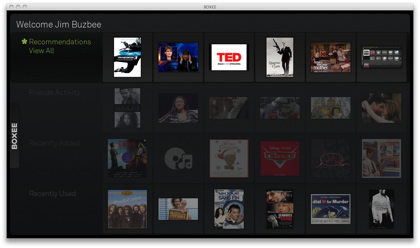
| At a Glance | |
|---|---|
| Product | boxee |
| Summary | Free open source media player based on XBMC with wide format compatibility |
| Pros | • Plays just about any format you have • Good use of metadata • Internet radio and video • Social networking integration |
| Cons | • Not available on Windows • Bad metadata omits content from indexes • AppleTV locked up with AC3 file • Crude video search |
A couple of years ago, I decided the time was right and I started ripping all of my DVDs to a hard drive—much like I’d done with my CDs years before that. Since then, I’ve experimented with numerous ways to play back my digital music, videos and pictures on my entertainment center via my home network.
I have tried a number of different players based on UPnP AV, Windows Media Center and other protocols. Eventually, I settled down with a hacked AppleTV that was tiny, silent and would play back most of my files. But I know that eventually I’ll have to move on, so I continue to keep my eyes open for a better solution.
Recently, a free software-based playback solution named boxee has been getting some buzz after winning $50,000 at the 2008 CES exhibition. Boxee is a fork of XBMC, the popular open source media center application that has been in development for quite a quite a while. What boxee brings to the party is a social layer. When using boxee, you can keep track of what your friends are watching and recommending and they can keep track of you. Sound interesting? Read on for my experiences with the package. I’ll primarily be reviewing boxee running on my Mac Book Pro. But I also took a stab at installation on my AppleTV, so I’ll touch I that as well.
Setup
The company behind boxee has stated that their goal is to get the software running on as many platforms as possible. But at the moment, boxee is available for Apple OSX, AppleTV and Linux users only. If you’re a Windows user, you’ll have to wait a little bit longer. An invitation-only release for Windows users is out, so Microsoft users should be able to try it out soon.
Getting going with boxee is fairly straightforward. Since one of the main features of boxee is social networking, the first step is signing up for an account on the boxee web site. Once you’re in, you’ll download and install the package (Figure1).
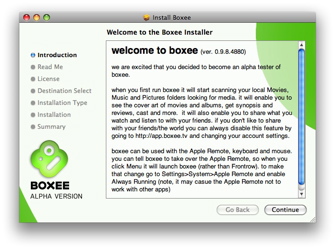
Figure 1: boxee installation
Note the “Alpha” designation in Figure 1, which tells you that this is a fairly early release. So some bugs are to be expected. However, even though this is an alpha release, boxee is based on the five- year-old XBMC. So the underlying infrastructure should be fairly solid.
When you have the package installed and running, you log in with your boxee account and start setting it up with your media. By default, boxee runs in full-screen mode and utilizes the standard remote that comes with most Apple computers. Even though it normally runs in full-screen, I have boxee running in a windowed mode in the following screen shots so that I can more easily capture images.
One of the main attractions of boxee is its "Swiss Army knife" ability to get data from practically anywhere and play almost any format. Figure 2 shows an initialization step where I’m adding a network share containing some of my video content.
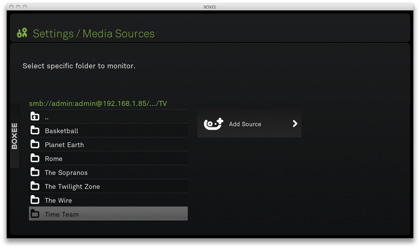
Figure 2: Adding a network share
In this case, I entered the info for a SMB share on my network and let boxee mount and scan the directories. I also could have mounted the share from OS X using any supported protocol and then just pointed boxee at the mounted directory.
Once you point boxee at your media, it will proceed to scan and catalog your files in the background. Depending on how much content you have, this can be a time-consuming process. Everything else bogs down during the scan. So if you have time, just start it up, walk away and let it do the initial import before trying to use it.
In general, I found boxee to use a lot of CPU. Even when doing little more than navigating menus, I would often hear my MacBook Pro fan kick on and see the CPU meter jump. Hopefully, this is just due to the Alpha state of the software and it will be fixed as development progresses.
Feature Tour – Music
Since the capabilities of boxee are extensive, I won’t be able to cover everything in this review. But I’ll try to hit all the major features. One of the really nice features is the automatic association of metadata such as album covers or movie posters with your files.
When it works, it’s nice. But it’s a really hard feature to implement correctly and often depends on how files are named. In Figure 3 below, you can see a menu of my music where many of my albums have been given artwork, but others have not.
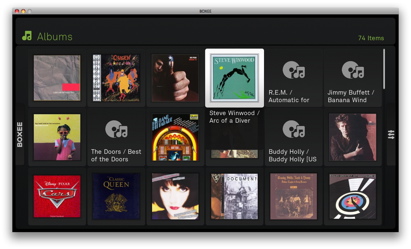
Figure 3: Album-art menu
In this case, an obscure album, “Big Band Hit Parade”, has been correctly identified. But more mainstream albums such as “Best of The Doors” or an R.E.M album have not. When an album is identified, you can select it and get a nice review such as seen in Figure 4.
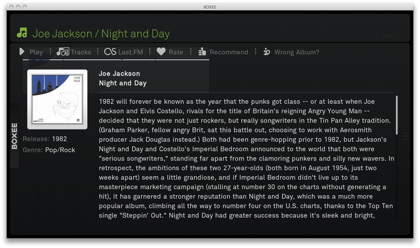
Figure 4: Album Info
It’s a bit hard to see in this menu, but the social networking aspects of boxee start to show up here. Along the top, there’s an option to rate the album or recommend it to the friends that you’ve associated with your account. You can also get set up a feed to Twitter so that all you "friends" can be notified when you are listening or rating music (or video).
There’s also a Wrong Album? button that comes in handy for corrections when boxee makes a wrong guess on your file. For example, I found that many of my “Greatest Hits” albums were incorrectly identified. (The Baja Marimba Band Greatest Hits, What? Where did that come from?)
A bigger problem, however, was with files that weren’t identified at all. These files just didn’t show up in the menus. If you remember you have them, you can only get to them by using the Browse feature to dig through the filesystem (Figure 5).
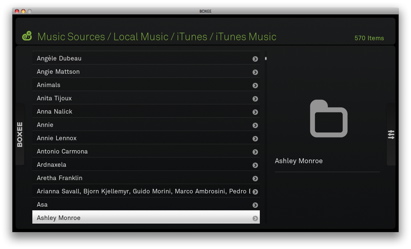
Figure 5: Browsing the filesystem
With this release of boxee (0.9.8.4880), there were only three ways to navigate through music: By Album, Artist or just browsing the filesystem. Hopefully, later releases will include other methods that most of us have come to expect such as song title, genre, composer, random, etc. I’d also suggest an "Unknown" grouping for those items that just can’t be identified.
When playing back music, you have the choice of various abstract displays and sometimes you can even get lyrics to accompany the song as shown in Figure 6.
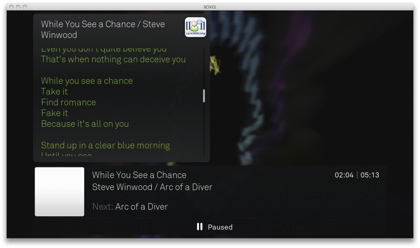
Figure 6: Music Playback with lyrics
Basically, if you have it (and it’s not DRM protected), boxee will likely play it (see Wikipedia for the list of supported formats). If you prefer to get your music from a Internet streaming source, or from a podcast, boxee has you covered there as well. Figure 7 shows the top-level Internet Music selection screen.
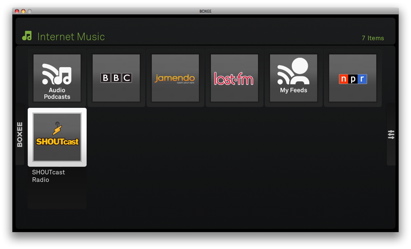
Figure 7: Internet Music
Like the other music feature, you have the ability to rate the streams and recommend them to your associated friends.
Feature Tour – Video
A tougher nut to crack than music is video. There are a lot of video formats and codecs out there, so it’s hard to get one system to handle them all. But this is where boxee has an advantage over other network media players. Since boxee uses software decoding, it handles a much broader set of supported formats than a hardware-based system.
The downside, of course, is that it requires a relatively powerful CPU to do the heavy lifting. I again won’t list all the formats supported here (see Wikipedia for the list). But suffice it to say, the list is extensive and even includes the ability to play back ripped DVDs with navigation menus intact.
In short, boxee was able to play everything I threw at it; and my video collection includes a lot of formats and encodings. Figure 8 shows a video selection screen where my movies are being browsed.
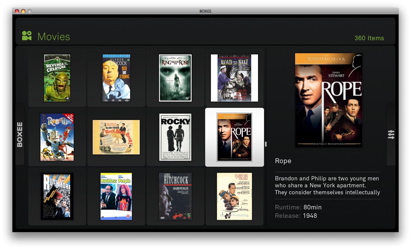
Figure 8: Movie Selection
Much like the music menus, all of the metadata was automatically associated and added, which was a real nice feature. But once again, after the initial database build was done, there were a lot of errors. I have a number of movies with identical names such as Hitchcock’s two different versions of The Man Who Knew Too Much. In these cases, boxee gave both the same metadata and I had to sort it out later. (I’ll note that I had a couple of crashes when sorting out duplicates, however.)
There were also cases where a corrupt image or a foreign-language movie poster was selected instead of an English version, and this wasn’t correctable. And like music, if a movie can’t be identified, it won’t show up at all. Since I have hundreds of movies in my library, it wasn’t obvious when something was missing.
The metadata for movies (Figure 9) is from the IMDB so it’s quite good. But I have to wonder about boxee potentially violating the IMDB terms-of-service, since it is a commercial entity.
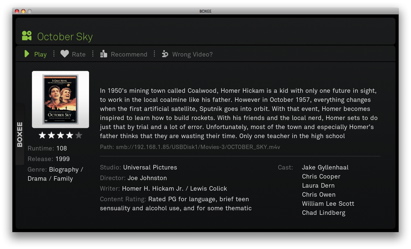
Figure 9: Movie metadata
Since there was a ton of metadata associated with the movies, I had hoped that I could search for movies via actor, director, genre, year, rating, etc. But as of now, searching is very crude. The only way to find a movie is by name or the date it was added to the library(?!). With my large collection, this was really inadequate and made finding a particular movie difficult.
For television, boxee uses TheTVDB for metadata. When I brought up my menu of TV shows, it was nice to see that boxee had added images and descriptions to some of my obscure British documentaries. But once again, anything that didn’t have metadata available didn’t show up at all, which essentially cut my collection in half.
You might wonder if boxee can handle HD video. It can, but since all decoding is done in software, it really depends on the power of your CPU. Figure 10 shows playback of my 720p recording of last year’s Final Four.
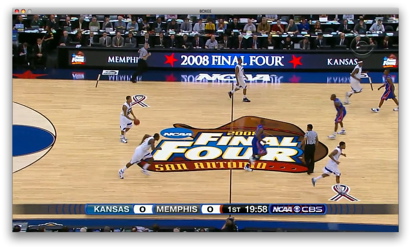
Figure 10: HD Playback
My 2 GHz Core Duo MacBook Pro played it back, but both CPUs were typically running at over 70% utilization. I would also see an occasional stutter as the data streamed over my 802.11g wireless network. Also note that If you want to fast-forward or reverse while playing video, you might want to wait for another release. These features were only barely usable with jumps, stuttering, pauses, etc.
As with other content types, "social networking" menus are available for recommending and rating video.
Internet Video
boxee has a long list of supported sites for streaming video from the Internet. Figure 11 shows the selection menu for Internet video.
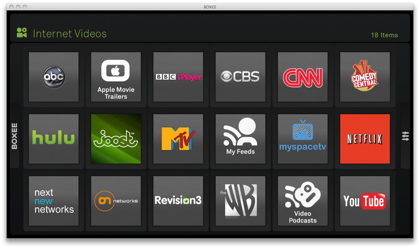
Figure 11: Internet Video
Of particular note is the support for Netflix’ "Watch Now" feature that is gaining support on numerous hardware platforms including the Roku Digital Video Player, Blu-ray players from LG and Samsung, Xbox 360 and TiVo’s HD DVR.
I don’t have a Netflix account so couldn’t try out that option. But I did watch a full-length movie from the Hulu server. It played, but it was a bit laggy and the quality wasn’t the greatest. But Internet video is an area to keep an eye on. It’s a pretty safe bet that it will eventually take over from plastic discs. But we ain’t there yet!
Pictures and more
If you want to view your digital photos on your TV, boxee has it covered. For locally-stored pictures, you’ll need to use the Browse feature to find a directory of pictures and then boxee will cycle through them in a slideshow.
Display options are available for several different parameters such as display time, pan/zoom effects, etc. There is also support for several online picture web repositories. Figure 12 shows a collection of my pictures from Picasa, which has a more attractive interface than the local picture viewer.
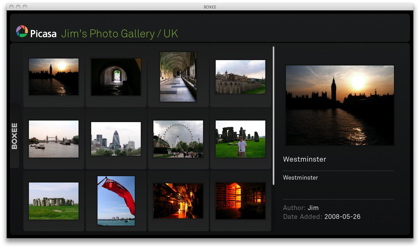
Figure 12: Picasa support
The Internet menu also shows support for flickr, The Big Picture and oddly enough, iPhoto, which is actually your local iPhoto directory structure.
Features I’ll mention but not cover are a Weather App which will show your current conditions, Download which is designed to do Torrent downloads (but it didn’t work for me), Screensaver options, and the ability to Skin the interface to make it look the way you want.
AppleTV
I was interested to see that there was a way to use boxee on an AppleTV, since that has been my primary digital media interface since I hacked it a while back. Unfortunately, the advertised method of adding boxee support (booting with a special USB key) would wipe out my existing hacks. But after digging a bit deeper, I found that I could manually do the boxee install by extracting the appropriate parts and adding things manually.
So how did it work? Figure 13 shows the main AppleTV menu with a new Launcher item where boxee can be started.
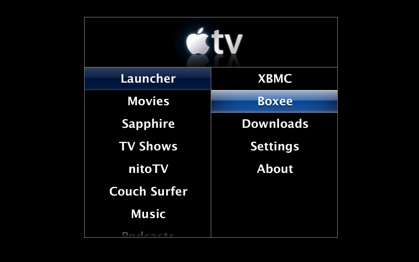
Figure 13: boxee on the AppleTV
Generally, the interface looked identical to the version running on my MacBook Pro. But since the AppleTV doesn’t have anywhere near the MacBook Pro’s horsepower (it has only a single 1Ghz CPU), boxee on the AppleTV felt a bit more sluggish and it didn’t stand a chance of playing back my HD basketball game.
I also ran into a serious glitch while trying it out. After attempting to play back a movie with embedded AC3 audio, all media audio stopped. I could still hear standard menu-press clicks. But anything else I tried, local music, steaming music, video, etc. were all silent. Fiddling with the audio settings didn’t help and rebooting didn’t either. I was stuck.
So, at least for me, boxee on the AppleTV is currently a no-go. I’ll keep an eye on it because it has some nice features such as playing DVDs with menu support and the nice streaming capabilities. But I’ll need to wait for an update to see my audio comes back.
Social Networking
As mentioned earlier, boxee is a spin-off from the standard XBMC, with a focus on the social networking aspects of multimedia. (What are your friends watching? Do I have any recommendations from my friends? ) As I mentioned earlier, boxee can post events to Twitter. So if I want the world to know when I secretly watch American Idol re-runs at 3 AM, I can do it.
boxee also can share movie watching and music listening habits via a web page. Figure 14, which shows my recent activities, is from the boxee web site.
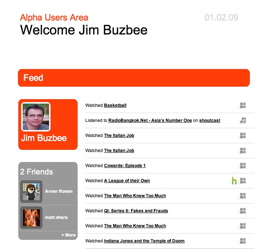
Figure 14 boxee web site
This screen basically shows all the videos and audio that I was experimenting with during the review. It’s a little bit deceptive, since several of the movies I tried didn’t work, so I didn’t really watch them. And the top item, Basketball was my name for the Final Four game so it’s meaningless to anyone other than me.
When I first brought up this screen, it made me a bit uncomfortable. Anyone, anywhere could see what I had been watching. I know some people who would freak out at this possibility. But then, boxee isn’t really geared toward them. There is an option to share only to friends or to not share anything at all. But the latter option kind of defeats one of the key aspects of boxee. It might be a good idea to have more selective control over your shared activities. But for now, it’s pretty much all or nothing.
Speaking of “friends”, the two shown in Figure 14 are a default “friend” and some guy who I just picked out at random to be my “friend”. So Matt, if you’re reading this and wondering who your new friend is: “Hi! And since you watched it recently, was Slumdog Millionaire really as good as they say?”.
The boxee web site also has configuration options such as setup for syncing with Twitter and other social networking sites, setting up your Netflix account, documentation (but not enough) and a user forum for help and discussions.
Closing Thoughts
Boxee is only in alpha release, but it looks to me like it has potential. The ability to play most anything I threw at it was a nice change from what I usually experience when reviewing media players. And its potential for using metadata looks promising too. I really like to sort my movies by genre, rating, actors, etc.
The “Social” features of boxee weren’t all that important to me. But a look at the number of people who use Facebook, MySpace and Twitter shows that there are a lot of people who are really into exchanging personal data.
I wonder if the boxee AppleTV port will ever really be good enough to compete with the other nice viewers that already exist for the box. But I’m willing to wait for a couple more releases to find out. And when the Windows port goes live, there will be a lot more users and feedback for the developers, which may well give boxee more momentum.
For now, if you’re an Apple (or Linux) user and interested in this type of capability, give it a shot. You can’t go too wrong with a free network multimedia player that can play just about anything you throw at it!
